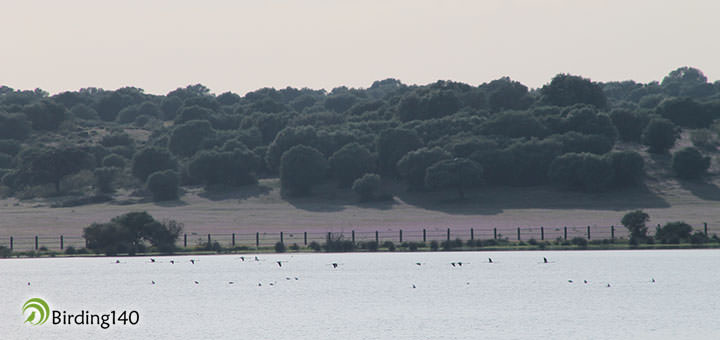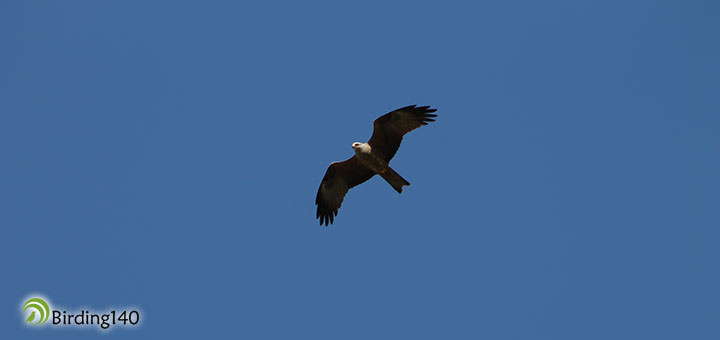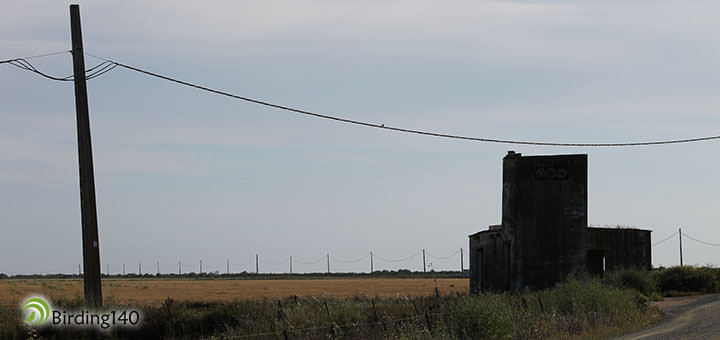The second edition of the Doñana Birdfair was held between 17 and 19 April. We took this exceptional event as an excuse to return to the paradise of Doñana.
The fair was smaller this year, with just one venue in the Dehesa de Abajo, in the municipality of La Puebla del Río (Seville). SEO/Birdlife has collaborated and taken part in Doñana Birdfair 2015, although the organizer this year has been Dehesa de Abajo itself.
The new organization has offered a different approach to the Doñana Birdfair, moving the celebration dates two weeks forward and giving a greater role to the ornithological tours.
As we were approaching Dehesa de Abajo from Seville, we noticed that the landscape had changed a bit from last year. This winter, rainfalls have been plentiful and both Dehesa de Abajo and Doñana were teeming with life.
When we arrived to the Doñana Birdfair, we entered the exhibitors’ tent, where we had the opportunity to greet Rafael Serra (whom we had also met at FIO, at the Quercus stand), and we confirmed that some of the initiatives promoting ornithological tourism that we had discovered at the fair last year have been taken forward, like Siberia Extremeña or the works of the Victoria Laporta Foundation in the Mariola mountain range (Alicante). At the Genatur and Strait of Gibraltar stands we could also gather very useful information in order to plan a future visit to Cadiz.
With regard to optics and photography equipment, Óptica Roma was there, and in an independent tent on the outside we could also see the brands Swarovski, Wildphotoscape and Kowa.
Conferences of the Doñana Birdfair 2015
From all the talks we could attend during Doñana Birdfair, we want to highlight Jorge Garzón’s “Escuela de Guías de Ecoturismo y Naturaleza” about the origins of the training courses for guides in Andalusia and the creation of the Al-Natural’s School of Ecotourism Guides, and Juan José Ramos Melo’s talk “Sahara’s Birds. 60 years after Jose Antonio Valverde”.
Juan José has visited the places that José Antonio Valverde travelled during his famous trip to the Spanish Sahara in 1955, which was the origin of the work “Birds of Spanish Sahara. Ecological study of the desert”. It is really interesting to find out the important changes that have been produced in the local fauna of remote areas. Human activity has caused changes even in completely uninhabited places, apparently safe from the hand of man.
We would also have liked to attend the exposition of the Seville Rice Farmers’ Federation (Federación de Arroceros de Sevilla); this talk, however, was withdrawn from the programme at the last minute. Perhaps in a future edition of Doñana Birdfair we will be able to learn more about the history of this crop in the Valley of Guadalquivir, and about its link with birds.
On Friday evening the volunteers from SEO/Birdlife showed us the lake of La Rianzuela, in the Dehesa de Abajo. From the lake’s observatory we could see the arrival of small flocks of flamingos and a friendly Great Crested Grebe fishing. We could also admire some Bee-eaters and a Black Kite recently arrived from Africa. It was a small foretaste of what we would discover the following day.
Tours on the surroundings of Doñana National Park
The best part of Doñana Birdfair 2015 were, without a doubt, the tours on the surroundings of the National Park. Four routes were organised with the departure point at the fair.
The Lynx Territory tour allowed visitors to go across the pine woods of Aznalcazar-Puebla and a stretch of the Guadiamar River close to the Dehesa de Abajo. The Isla Mínima. Birds and Rice tour passed through the places where the film Marshland (La Isla Mínima) was shot, and the Doñana’s National Park tour reached up to the José Antonio Valverde visitor centre.
There was a fourth route which consisted on a boat tour on the Guadalquivir River from Seville to the pier close to the village of Alfonso XIII. Unfortunately, it was replaced weeks before the Doñana Birdfair by a car tour along the green corridor of the Guadiamar River.
On our way to Doñana National Park
We decided to take part in the scheduled trip to the National Park on Saturday afternoon. We left at 15:00 from Dehesa de Abajo heading south in a van driven by our guide Mónica. We left La Rianzuela Lake and a group of British birdwatchers on the right.
We gradually got into the area of the Natural Park. As we moved forward, the pavement was becoming thinner and thinner, until we ended up driving on a bumpy but beautiful country road.
We were surrounded by rice fields, some of them still in dry land, some flooded with a thin layer of water, and the fewest of them already painted with the green and yellow colours of the rice stalks in growth.
At the beginning of our trip through Doñana, the most impressive thing was the sound that reached our ears. From the vehicle we could only see a few dozens of birds, but we could hear thousands of them. The more we went to the south, the loudest the sound of nature was.
Due to the peculiar geological origin of these lands, a large area of Doñana is an enormous plain. A few thousand years ago, this place was occupied by the waters of a huge gulf where the Guadalquivir River flew into. Century after century, the river had been leaving sediments in the gulf until it got completely covered. For this reason, these lands are nowadays almost totally plain.
We stopped at a small bridge over one of the streams that bring the fresh water of the Guadalquivir River to the rice fields. Hundreds of Black-winged Stilts and Glossy Ibis were looking for food, mesmerised by the attraction of fresh water.
We could photograph them at pleasure, without noticing that a curious bird of prey was approaching us from behind. When we lifted our heads, we were caught by surprise by a magnificent Western Marsh Harrier which observed our movements from above.
When our observer went away, we returned to the road and a couple of kilometres away we found an old construction which had been renovated as a kestrel barn with the installation of a dozen nest boxes. Several couples of Lesser Kestrel were flying around, allowing us to see them.
After enjoying this show, we continued our route towards the José Antonio Valverde Visitor Centre. Just before arriving we made a last stop at the Lucio de las Gangas, small natural lakes located just in the limit between the Natural Park and the National Park, between the swamp turned into a rice crop and the unaltered swamp.
In a short walk we could see flamingos, spoonbills, coots, Red-crested Pochards and a Western Marsh Harrier which intermittently flew over the most flooded area. When we were already returning to our vehicles, we got startled by a small group of Glossy Ibis flying over our heads. It was spectacular!
José Antonio Valverde Visitor Centre
The last stop of our route was the enormous building of the José Antonio Valverde Visitor Centre. This big unit simulates the traditional marshland huts on the outside, and on the inside it hosts an exhibition explaining the effects of the different seasons on the marshland.
The most characteristic feature of the visitor centre are the large windows that offer a view of the artificial pool located behind the building and what happens over its sheet of water. We arrived shortly before the closing time, so couldn’t stay long, but we did enjoy the flamingos that were feeding on the edge of the lake and the flocks of Cattle Egrets, accompanied by some Black-crowned Night Herons, which were resting on the vegetation of the pool.
The evening came and it was time to return to Dehesa de Abajo. On our way back, the colours of the marshland and the rice fields were changing as the light was falling. A powerful Short-toed Snake Eagle came to say goodbye when we were already on our way to the north. She was standing close to the road and seemed to say: “See you soon, birdwatchers”.
As a conclusion to our visit to Doñana Birdfair 2015, we can say that, although it was smaller than last year, we have enjoyed a great fair. The guided tours through Doñana have been a success and we left the place very satisfied with our experience. We won’t hesitate to come back next year for Doñana Birdfair 2016.
If you found this post interesting and you think it deserves being shared, please share it on your social networks.






















